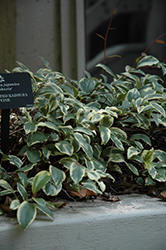It's all about ...
plants

Fukurin Kadsura Vine
Kadsura japonica 'Fukurin'
Height: 12 feet
Spread: 3 feet
Sunlight:
![]()
![]()
![]()
Hardiness Zone: 8a
Description:
An ornamental vine with glossy, tri-color variegated leaves; makes a beautiful screen when grown on a trellis or arbor; leaves can scorch but are tolerant of the heat when watered adequately; deciduous in coldest winters but re-foliates quickly in spring
Ornamental Features
Fukurin Kadsura Vine is primarily valued in the landscape or garden for its broadly spreading habit of growth. It features subtle nodding buttery yellow star-shaped flowers along the branches from early to late summer. It has attractive dark green foliage edged in creamy white with hints of bluish-green which emerges buttery yellow in spring. The large glossy oval leaves are highly ornamental and remain dark green throughout the winter.
Landscape Attributes
Fukurin Kadsura Vine is a multi-stemmed evergreen woody vine with a twining and trailing habit of growth. Its average texture blends into the landscape, but can be balanced by one or two finer or coarser trees or shrubs for an effective composition.
This is a relatively low maintenance woody vine, and is best pruned in late winter once the threat of extreme cold has passed. It has no significant negative characteristics.
Fukurin Kadsura Vine is recommended for the following landscape applications;
- Accent
- Hedges/Screening
- General Garden Use
- Container Planting
Planting & Growing
Fukurin Kadsura Vine will grow to be about 12 feet tall at maturity, with a spread of 3 feet. As a climbing vine, it tends to be leggy near the base and should be underplanted with low-growing facer plants. It should be planted near a fence, trellis or other landscape structure where it can be trained to grow upwards on it, or allowed to trail off a retaining wall or slope. It grows at a fast rate, and under ideal conditions can be expected to live for approximately 20 years. This is a dioecious species, meaning that individual plants are either male or female. Only the females will produce fruit, and a male variety of the same species is required nearby as a pollinator.
This woody vine performs well in both full sun and full shade. It does best in average to evenly moist conditions, but will not tolerate standing water. It is not particular as to soil pH, but grows best in rich soils. It is somewhat tolerant of urban pollution. Consider applying a thick mulch around the root zone over the growing season to conserve soil moisture. This is a selected variety of a species not originally from North America.
Fukurin Kadsura Vine makes a fine choice for the outdoor landscape, but it is also well-suited for use in outdoor pots and containers. Because of its spreading habit of growth, it is ideally suited for use as a 'spiller' in the 'spiller-thriller-filler' container combination; plant it near the edges where it can spill gracefully over the pot. It is even sizeable enough that it can be grown alone in a suitable container. Note that when grown in a container, it may not perform exactly as indicated on the tag - this is to be expected. Also note that when growing plants in outdoor containers and baskets, they may require more frequent waterings than they would in the yard or garden. Be aware that in our climate, most plants cannot be expected to survive the winter if left in containers outdoors, and this plant is no exception. Contact our experts for more information on how to protect it over the winter months.
This plant is not reliably hardy in our region, and certain restrictions may apply; contact the store for more information.
